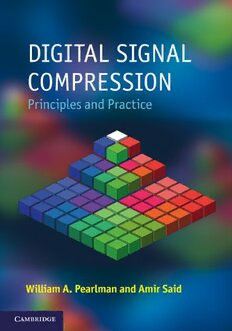
Digital signal compression : principles and practice PDF
Preview Digital signal compression : principles and practice
DigitalSignalCompression Withclearandeasy-to-understandexplanations,thisbookcoversthefundamentalcon- cepts and coding methods of signal compression, while still retaining technical depth andrigor.Itcontainsawealthofillustrations,step-by-stepdescriptionsofalgorithms, examples, and practice problems, which make it an ideal textbook for senior under- graduate and graduate students, as well as a useful self-study tool for researchers and professionals. Principles of lossless compression are covered, as are various entropy coding tech- niques,includingHuffmancoding,arithmeticcoding,run-lengthcoding,andLempel– Zivcoding.Scalarandvectorquantization,andtheiruseinvariouslossycompression systems,arethoroughlyexplained,andafullchapterisdevotedtomathematicaltrans- formations,includingtheKarhunen–Loevetransform,discretecosinetransform(DCT), and wavelet transforms. Rate control is covered in detail, with several supporting algorithms to show how to achieve it. State-of-the-art transform and subband/wavelet image and video coding systems are explained, including JPEG2000, SPIHT, SBHP, EZBC, and H.264/AVC. Also,unique tothis book is achapter on setpartition coding thatshedsnewlightonSPIHT,SPECK,EZW,andrelatedmethods. WilliamA.Pearlman is a Professor Emeritus in the Electrical, Computer, and Systems Engineering Department at the Rensselear Polytechnic Institute (RPI), where he has beenafacultymembersince1979.Hehasmorethan35yearsofexperienceinteaching and researching in the fields of information theory, data compression, digital signal processing,anddigitalcommunicationstheory,andhehaswrittenabout250published worksinthesefields.HeisaFellowoftheIEEEandtheSPIE,andheistheco-inventor oftwocelebratedimagecompressionalgorithms:SPIHTandSPECK. AmirSaidiscurrentlyaMasterResearcheratHewlett-PackardLaboratories,wherehe has worked since 1998. His research interests include multimedia communications, coding and information theory, image and video compression, signal processing, and optimization, and he has more than 100 publications and 20 patents in these fields. He is co-inventor with Dr. Pearlman of the SPIHT image compression algorithm and co-recipient, also with Dr. Pearlman, of two Best Paper Awards, one from the IEEE CircuitsandSystemsSocietyandtheotherfromtheIEEESignalProcessingSociety. Digital Signal Compression Principles and Practice WILLIAM A. PEARLMAN RensselearPolytechnicInstitute,NewYork AMIR SAID Hewlett-PackardLaboratories,PaloAlto,California CAMBRIDGE UNIVERSITY PRESS Cambridge,NewYork,Melbourne,Madrid,CapeTown, Singapore,SãoPaulo,Delhi,Tokyo,MexicoCity CambridgeUniversityPress TheEdinburghBuilding,CambridgeCB28RU,UK PublishedintheUnitedStatesofAmericabyCambridgeUniversityPress,NewYork www.cambridge.org Informationonthistitle:www.cambridge.org/9780521899826 (cid:2)c CambridgeUniversityPress2011 Thispublicationisincopyright.Subjecttostatutoryexception andtotheprovisionsofrelevantcollectivelicensingagreements, noreproductionofanypartmaytakeplacewithoutthewritten permissionofCambridgeUniversityPress. Firstpublished2011 PrintedintheUnitedKingdomattheUniversityPress,Cambridge AcatalogrecordforthispublicationisavailablefromtheBritishLibrary LibraryofCongressCataloginginPublicationdata Pearlman,WilliamA.(WilliamAbraham) Digitalsignalcompression:principlesandpractice/WilliamA.Pearlman,AmirSaid. p. cm. Includesbibliographicalreferencesandindex. ISBN978-0-521-89982-6(hardback) 1. Datacompression(Telecommunication) 2. Signalprocessing–Digitaltechniques. I. Said,Amir. II. Title. TK5102.92.P43 2011 (cid:3) 005.746–dc23 2011012972 ISBN978-0-521-89982-6Hardback Additionalresourcesforthispublicationatwww.cambridge.org/9780521899826 CambridgeUniversityPresshasnoresponsibilityforthepersistenceor accuracyofURLsforexternalorthird-partyinternetwebsitesreferredto inthispublication,anddoesnotguaranteethatanycontentonsuch websitesis,orwillremain,accurateorappropriate. ToEleanor ToCelloandRicardo Contents Preface pagexv Acknowledgments xix 1 Motivation 1 1.1 Theimportanceofcompression 1 1.2 Datatypes 2 1.2.1 Symbolicinformation 2 1.2.2 Numericalinformation 3 1.3 Basiccompressionprocess 4 1.4 Compressionapplications 5 1.5 Designofcompressionmethods 6 1.6 Multi-disciplinaryaspect 8 Note 8 References 9 2 Bookoverview 10 2.1 Entropyandlosslesscoding 10 2.2 Quantization 11 2.3 Sourcetransformations 12 2.3.1 Prediction 12 2.3.2 Transforms 13 2.4 Setpartitioncoding 16 2.5 Codingsystems 17 2.5.1 Performancecriteria 17 2.5.2 Transformcodingsystems 18 2.5.3 Subbandcodingsystems 19 2.6 Distributedsourcecoding 20 Notes 21 References 22 3 Principlesoflosslesscompression 23 3.1 Introduction 23 3.2 Losslesssourcecodingandentropy 23 viii Contents 3.3 Variablelengthcodes 28 3.3.1 Uniquedecodabilityandprefix-freecodes 28 3.3.2 Constructionofprefix-freecodes 28 3.3.3 Kraftinequality 30 3.4 Optimalityofprefix-freecodes 32 3.4.1 Sourceswithmemory 36 3.5 Concludingremarks 37 Problems 37 References 40 4 Entropycodingtechniques 41 4.1 Introduction 41 4.2 Huffmancodes 41 4.3 Shannon–Fano–Eliascodes 47 4.3.1 SFEcodeexamples 48 4.3.2 DecodingtheSFEcode 49 4.4 Arithmeticcode 50 4.4.1 Preliminaries 50 4.4.2 Arithmeticencoding 51 4.4.3 Arithmeticdecoding 53 4.5 Run-lengthcodes 55 4.6 Alphabetpartitioning:modifiedHuffmancodes 57 4.6.1 ModifiedHuffmancodes 57 4.6.2 Alphabetpartitioning 58 4.7 Golombcode 60 4.8 Dictionarycoding 63 4.8.1 TheLZ78code 64 4.8.2 TheLZWalgorithm 65 4.8.3 TheLZ77codingmethod 67 4.9 Summaryremarks 72 Problems 72 Notes 75 References 76 5 Lossycompressionofscalarsources 77 5.1 Introduction 77 5.2 Quantization 77 5.2.1 Scalarquantization 77 5.2.2 Uniformquantization 81 5.3 Non-uniformquantization 87 5.3.1 Highrateapproximations 89 5.4 Companding 91 5.4.1 Distortionathighrates 93 Contents ix 5.5 Entropycodingofquantizeroutputs 95 5.5.1 Entropycodedquantizercharacteristics 98 5.5.2 Null-zonequantization 99 5.6 Boundsonoptimalperformance 101 5.6.1 Rate-distortiontheory 102 5.6.2 TheGish–Piercebound 104 5.7 Concludingremarks 107 5.8 Appendix:quantizationtables 107 Problems 109 Note 113 References 114 6 Codingofsourceswithmemory 116 6.1 Introduction 116 6.2 Predictivecoding 116 6.2.1 Optimallinearprediction 117 6.2.2 DPCMsystemdescription 120 6.2.3 DPCMcodingerrorandgain 121 6.3 Vectorcoding 122 6.3.1 Optimalperformancebounds 122 6.3.2 Vector(block)quantization(VQ) 129 6.3.3 Entropyconstrainedvectorquantization 135 6.4 Tree-structuredvectorquantization 141 6.4.1 VariablelengthTSVQcoding 144 6.4.2 PrunedTSVQ 145 6.5 Treeandtrelliscodes 146 6.5.1 Trelliscodes 148 6.5.2 Encodinganddecodingoftrelliscodes 150 6.5.3 Codevectoralphabets 152 6.6 Trelliscodedquantization(TCQ) 152 6.6.1 Entropy-codedTCQ 154 6.6.2 Improvinglow-rateperformanceinTCQ 155 6.7 Searchalgorithms 155 6.7.1 M-algorithm 155 6.7.2 TheViterbialgorithm 158 6.8 Concludingremarks 160 Problems 160 Notes 163 References 164 7 Mathematicaltransformations 166 7.1 Introduction 166 7.1.1 Transformcodinggain 169 x Contents 7.2 TheoptimalKarhunen–Loevetransform 171 7.2.1 Optimaltransformcodinggain 172 7.3 Suboptimaltransforms 172 7.3.1 ThediscreteFouriertransform 172 7.3.2 Thediscretecosinetransform 173 7.3.3 TheHadamard–Walshtransform 174 7.4 Lappedorthogonaltransform 175 7.4.1 Exampleofcalculationoftransformcodinggain 178 7.5 Transformsviafilterbanks 179 7.6 Two-dimensionaltransformsforimages 181 7.7 Subbandtransforms 184 7.7.1 Introduction 184 7.7.2 Codinggainofsubbandtransformation 187 7.7.3 Realizableperfectreconstructionfilters 192 7.7.4 Orthogonalwavelettransform 194 7.7.5 Biorthogonalwavelettransform 199 7.7.6 Usefulbiorthogonalfilters 204 7.7.7 Theliftingscheme 205 7.7.8 Transformswithintegeroutput 208 7.8 Concludingremarks 211 Problems 212 Notes 214 References 216 8 Ratecontrolintransformcodingsystems 218 8.1 Rateallocation 218 8.1.1 Optimalrateallocationforknownquantizercharacteristics 220 8.1.2 Realizingtheoptimalrateallocation 223 8.1.3 Fixedlevelquantization 225 8.1.4 Optimalbitallocationforarbitrarysetofquantizers 226 8.1.5 Buildinguptooptimalratesforarbitraryquantizers 228 8.1.6 Transformcodinggain 230 8.2 Subbandrateallocation 233 8.2.1 Practicalissues 237 8.2.2 Subbandcodinggain 239 8.3 Algorithmsforrateallocationtosubbands 241 8.4 Conclusions 242 Problems 242 Notes 243 References 244 9 Transformcodingsystems 245 9.1 Introduction 245
